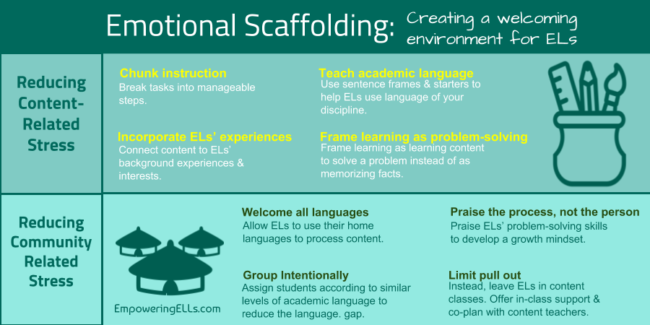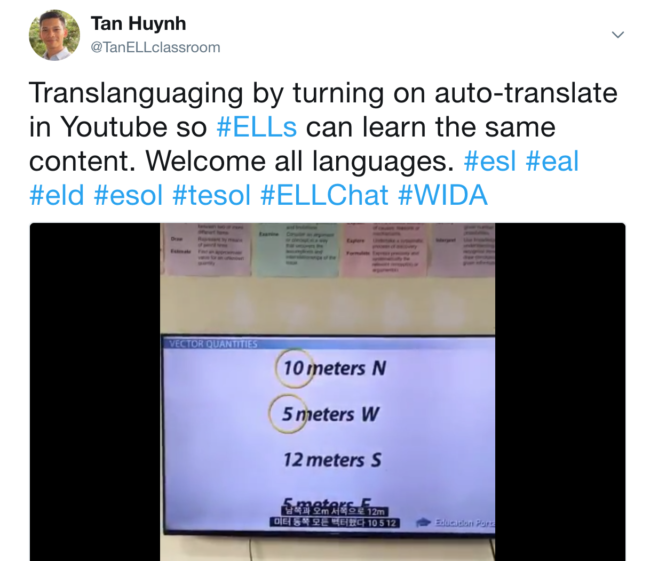When we think about scaffolding instruction for ELs, we often refer to using strategies that make content more accessible by using sensory, interactive, graphic, and language scaffolds. However, we rarely think about scaffolding how ELs feel while engaging in our classes.
How ELs feel at school is as important as what they learn.In addition to the graphic scaffolds listed above, Galina (Halla) Jmourko also encourages using scaffolds that lower the affective filter for ELs, which she termed as “Environment Scaffolds”. This theory is the belief that the amount of stress an EL feels in class directly impacts how much they learn.
I'd to share a tool I developed emphasizing the need of situating #scaffolding #LD Supports in #LearningEnvironment inclusive of diversity. #ELLs who engage when supported in comprehension of & communication during lessons. #LD Supports are extended to include Verbal & Textual. pic.twitter.com/gBWh7X7Fu9
— Halla Jmourko (@HallaJmourko) February 11, 2018
Learning for ELs is usually nerve-wracking because they are learning in an environment where the main language is different than the one they know at home. When we lose our ability to communicate and to be understood, we tend to withdraw from participating.
This stress can drastically reduce the effectiveness of instruction as ELs are devoting more of their emotional and intellectual capacities to assimilation (to not be the target of ridicule or isolation) rather than to the acquisition of academic content.
In other words, learning content becomes a secondary focus when ELs are still learning to be like other students. That’s why it’s so important to incorporate these environmental or emotional scaffolds for our ELs. Consequently, I’ve adapted Jmourko’s list and grouped her strategies into two categories:
- Strategies that reduce content-related stress
- Strategies that reduce community-related stress.
1. Reduce Content-Related Stressors
These scaffolds make learning content less stressful for ELs. When content is challenging, ELs affective filter rises and so do their stress levels. And when stressed, they are not in the emotional state to learn or participate.
The scaffolds that reduce content-related stress include:
Incorporating MLs’ personal experiences
When content is related to ELs’ experiences, learning content knowledge is easier. Content knowledge is cognitively easier to process when it’s connected to ELs’ experiences.
For example, Mr. L and Ms. E, 8th-grade Individuals and Society teachers (IB speak for history teachers), wanted to teach the concept of influence. They realized that many students, including ELs, are highly engaged with social media. Therefore, they framed the unit around studying how social media influences teens. If you want further information on this scaffold, please read this article devoted entirely to incorporating ELs’ experiences.
Chunking instruction
If you ever hear ELs say, “I don’t know where to start”, then that’s an indicator that the instructions have not been broken down enough step-by-step. When we give ELs a project without dissecting it into individual steps, we can guarantee that they won’t reach the highest level of attainment.
Clear, organized steps guide students from one part of a project to the next, making the entire task a less overwhelming experience. For example, instead of telling students to write an essay, we might start by point out the first step to writing an essay: brainstorming ideas.
To read an entire article about chunking, refer to this post.
Framing learning as problem-solving
ELs are often given highly remedial tasks significantly below their intellectual level because their developing English skills restricts the sophistication with which they can communicate. Instead of piling ELs with tasks that require more memorizing of information, frame learning as solving problems. For example, instead of completing a report about renewable energy in science class, students can write a proposal about ways a school can reduce its environmental footprint.
To learn more about how to create different contexts to meaningfully learn the language, please read this post.
Teaching discipline-specific language
Every discipline has its own rules for using language. The way you narrate a personal experience is different than the language you use to describe the steps of an experiment. These language expectations must be made explicit for ELs to be successful. One of the most effective strategies to teach discipline-specific language is to use sentence starters. These help ELs jump start the thinking by providing the language in the beginning. The ELs must apply their knowledge finish the sentence.
For more complex ideas that require connections between ideas, use sentence frames such as, “If…increases, then…because…”, which is the sentence frame the teachers in our science department use with ELs.
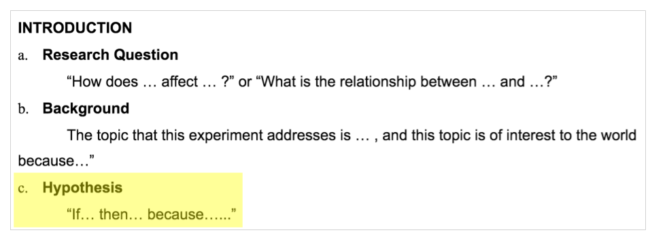
Teachers who want more detailed information about teaching content-specific language can read this article.
2. Reduce Community-Related Stress
Welcoming all languages
We are not fully alive when we have to hide parts of our identity. For ELs, they don’t fully show up when they’re not allowed to use their home languages at school. We have to dismantle “English only” policies and embrace translanguaging so that ELs can use any language at any phase of the lesson to help them process information and engage with tasks.
For example, Mr. A, a 7th-grade science, wanted students to learn about the different kind of forces. He had his students all watch the same video but kindly turned on Youtube’s auto-translate ability so that the ELs could watch with subtitles in their own language.
I understand some teachers’ good intentions in creating English-only policies, but when creating these restrictions, we turn our backs on an asset that spurs learning and jumpstarts engagement. Instead, teach in a way that reveals ELs’ potential rather than merely plugging gaps in their knowledge.
For more information related to incorporating ELs’ home languages, please read my guest post on Larry Ferlazzo’s Education Week Teacher blog.
Praising the process vs. the person
When students hear, “You are very smart”, they really hear “Some people are born smart and some aren’t”. Messages like the latter don’t develop a growth mindset that prioritizes problem-solving skills over the ability to memorize and regurgitate facts.
In contrast, messages that praise ability motivate ELs to develop skills. They also communicate that learning is a skill rather than an occurrence. For example, instead of saying, “You are a good reader,” we can say, “You read carefully when you…”
Praising ELs for their skills encourages them to adopt a growth-mindset where they believe that they can learn and engage in tasks like everyone else. When ELs see that they can work on the same challenging tasks as others, they feel better about being part of the school.
For more ideas related to the language around praising students, read this article by the American Psychological Association.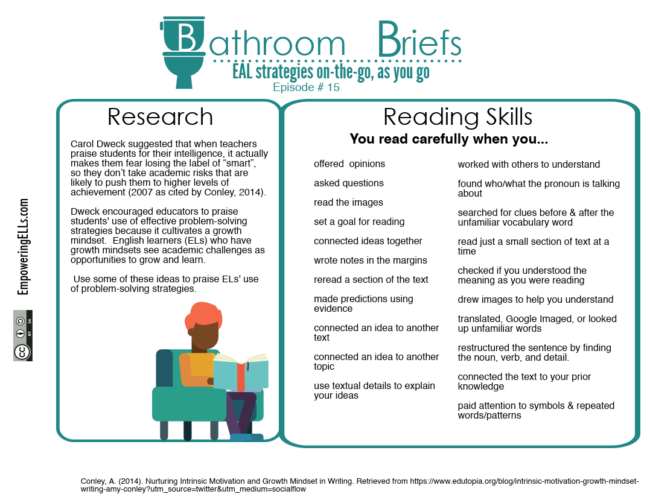
Grouping intentionally
Learning is by design, so grouping students should be too. NPR produced an article about how the U.S. Air Force tested our assumption of grouping. The result from the test suggests that grouping the highest-performing officers with least-performing ones had a negative effect on learning.
This is true for grouping students. Working with others can be a faint-inducing experience for many ELs. Though many of them come from highly social cultures, ELs might not feel confident working in groups mainly due to their developing English. This stress balloons when a Beginning EL works with a top performing student. The language gap frustrates the advanced student because she feels she has to do most of the work while the EL is deflated by his inability to contribute meaningfully.
There are 3 tips teachers can remember to practice grouping intentionally:
- Group students based on their academic language skills so their level of communication is similar. This makes them feel more secure when interacting with their peers because there isn’t a canyon-sized language gap.
- Never say, “Go find a partner.” It’s akin to being picked last for the basketball game. Who wants the pressure of being socially isolated in that way?
- Don’t restore to online grouping software because it doesn’t group according to student needs. A software doesn’t know your students, so it shouldn’t be assigning the groups.
See this article on intentionally grouping ELs for a more detailed account of this concept.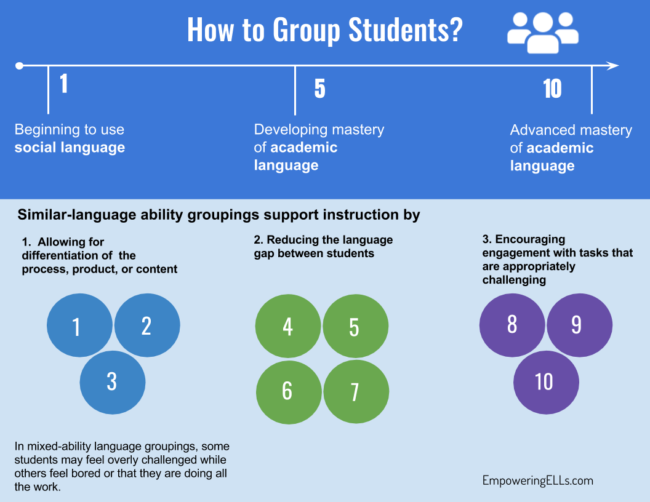
Differentiating the process, product, or content
ELs can master any grade-level standard that non-ELs can if the process is differentiated. Find ways for ELs to learn content using alternative approaches, such as watching a video connected to the unit’s topic instead of reading or talking about the text in same-language groups instead of alone. Teachers can also offer an additional graphic organizer that further breaks down the task into specific steps.
If we differentiate the process, we can also differentiate the product. A video, an infographic, or an oral presentation can be alternative products for full-length written assignments. The product can be fluid as long as it aligns with the content standard.
When working with skills or concepts, we can also differentiate the content. For example, if students are learning about the concept of power, we might allow them to study power related to their personal experience. This means we might allow them to study their favorite TV series instead of studying about the American Civil War.
Differentiation makes learning more welcoming and fulfills ELs’ need to feel secure and their desire to prove that they are as capable as non-ELs. For further reading on differentiation for ELs, you can read this article.
Limiting pull-out
Pulling ELs out for extended periods of the school day may be well-intentioned, but it can shrivel an EL’s identity and confidence in a short period of time. Pulled out students not only feel like they are different from other students, they also have fewer opportunities to interact with other classmates, further isolating them. On these islands of isolated learning, ELs might not be exposed to the same grade-level content or held to the same rigor. And when they eventually return to mainstream classes, they might be academically behind other students due to these reasons.
Instead of pulling ELs out, I recommend having them learn alongside their non-EL classmates. As language educators, we need to co-plan with content teachers and offer in-class support to make content comprehensible. When providing in-class support rather than pulling students out, we focus on capitalizing on what ELs can do rather than dwelling on what they can’t.
This post provides an in-depth article about abandoning pull-out practices.
Assessing content, not language
To attend school is to be evaluated and assessed. ELs can’t escape this, and while many were the top of their class in their home countries, they often drop to the bottom upon entering American schools because their language skills do not reflect their abilities. This further withers away their identity as a student and shatters their sense of security while at school.
Instead of assessing how they communicate in writing and speech, only evaluate their mastery of content and their ability to apply skills. Doing so puts ELs at ease so they can focus on content rather than grammar.
Takeaways
When working with ELs, teachers often ask about strategies to scaffold content. That is akin to wanting to cross the street but only checking to see if cars are coming from one side. Students bring their hearts along with their heads to school, so we have to reach for both if we want them to feel safe to learn in our communities. Before we even employ teaching strategies, we need to develop a supportive relationship with ELs so that they trust enough in us to learn from us.
Leave a comment below to share how you help ELs feel welcomed and safe in your schools?

